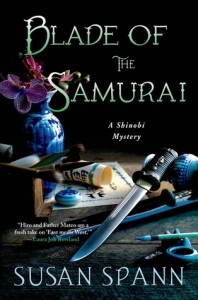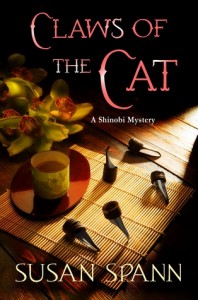 Format read: ebook provided by Edelweiss
Format read: ebook provided by EdelweissFormats available: ebook, hardcover
Genre: Historical mystery
Series: Shinobi Mysteries, #2
Length: 304 pages
Publisher: Minotaur Books
Date Released: July 15, 2014
Purchasing Info: Author’s Website, Publisher’s Website, Goodreads, Amazon, Barnes & Noble, Kobo, Book Depository
June, 1565: Master ninja Hiro Hattori receives a pre-dawn visit from Kazu, a fellow shinobi working undercover at the shogunate. Hours before, the shogun’’s cousin, Saburo, was stabbed to death in the shogun’s palace. The murder weapon: Kazu’s personal dagger. Kazu says he’s innocent, and begs for Hiro’s help, but his story gives Hiro reason to doubt the young shinobi’s claims.
When the shogun summons Hiro and Father Mateo, the Portuguese Jesuit priest under Hiro’s protection, to find the killer, Hiro finds himself forced to choose between friendship and personal honor.
The investigation reveals a plot to assassinate the shogun and overthrow the ruling Ashikaga clan. With Lord Oda’s enemy forces approaching Kyoto, and the murderer poised to strike again, Hiro must use his assassin’s skills to reveal the killer’s identity and protect the shogun at any cost. Kazu, now trapped in the city, still refuses to explain his whereabouts at the time of the murder. But a suspicious shogunate maid, Saburo’s wife, and the shogun’s stable master also had reasons to want Saburo dead. With the shogun demanding the murderer’s head before Lord Oda reaches the city, Hiro and Father Mateo must produce the killer in time . . . or die in his place.
My Review:
Blade of the Samurai takes place one year after the successful conclusion of the case that marked the opening book in this terrific series, Claws of the Cat (reviewed here).
 Just like Claws of the Cat, the mystery in Blade of the Samurai is steeped in Japanese politics and culture. At the same time, the possible suspects for the murder include many whose motives are purely personal.
Just like Claws of the Cat, the mystery in Blade of the Samurai is steeped in Japanese politics and culture. At the same time, the possible suspects for the murder include many whose motives are purely personal.
It is up to the shinobi Hiro to determine the real killer. In this case, he is drawn into the mystery because his fellow shinobi, Kazu, a secret informer planted within the shogunate itself, may be the killer. Or he may just have been a young idiot.
Hiro must find the true killer in order to keep his, and Kazu’s, secrets. But he fears that Kazu is lying to him, and that he is the murderer after all. For the sake of his own honor, Hiro must determine the truth.
It is possible that the murder is part of a plot to overthrow the shogun. It is also possible that the victim’s lover murdered him, or that his wife murdered him for threatening to divorce her. Even more confusing for Hiro, it is entirely possible that the man was murdered because he was an unpleasant, privileged asshat that made certain that everyone near him hated him.
There are many too many possible suspects. The field narrows when they start dying in suspicious circumstances. Hiro is certain that a string of supposed suicides among people who have information for his investigation is well beyond the range of coincidence.
Hiro wants Kazu to be innocent, or at least as innocent as their mutual profession allows them to be. But the longer Kazu refuses to admit where he was on the night of the initial murder, the guiltier he looks. And Kazu is guilty, but not of this crime. Just of being a young idiot.
It is astonishing to discover that Hiro is only 25, and that his friend Kazu is merely 20. But Kazu’s actions make much more sense in light of his age.
Kazu is not the only person covering up the truth in this case. The maid who discovered the body has almost as many faces as the two shinobi.
Following along in Hiro’s footsteps is a fascinating pleasure. In this particular case, while his uncovering of the killer is absorbing, even more fascinating is the aftermath. The secrets revealed at the end change our perceptions of the case and the investigators.
Blade of the Samurai is historical mystery as it should be done.
Escape Rating A+: As much as I loved this, I still want the story of Hiro and Mateo’s first meeting, or Hiro’s assignment to Mateo’s case. Whatever happened there must be fascinating, as well as revelatory.
But this case kept me on the edge of my seat. There are so many possible motives for the crime, and Hiro is trapped in the investigation. Not just because Kazu is a comrade, but also because Mateo is attacked during the investigation and is too injured to leave Kyoto. Hiro can’t get out of solving the crime, in the hopes that the answer will provide a respite for the growing political tension.
He’s almost half right.
Unlike so many mysteries, there are actually two plots, and the coincidence does work. Hiro solves what he can, but some things are beyond his ability to solve, as one plot uses the other as cover. It doesn’t feel like two half-baked ideas in search of a story, these two separate strings tie together in a way that makes sense.
We also learn more about Hiro, his abilities and his philosophy, and the relationship between himself and Mateo. Their friendship surprises him, and makes his job more difficult. It also provides Hiro with a vulnerability that shinobi are not supposed to have. Yet, it provides the motivation for his crime solving.
One of the things I’m most looking forward to in the series is their evolving relationship. Mateo is often our viewpoint for how things differ from the Western history and perspective that we are more familiar with. At the same time, he is trying to adapt to the culture around him. We, and Hiro, often can’t tell whether Mateo is using his foreign-ness to ask rude questions, or whether he honestly doesn’t know.
The ending of this story was a surprise, in a good way. While the plots were wrapped up and the motives for the perpetrators revealed, it was the aftermath that stuck in the mind. Not just for its revelations, for also for the way that it went outside the code, yet still remained true to the setting.

~~~~~~GIVEAWAY~~~~~~
Susan is giving away a copy of Blade of the Samurai (print or ebook, winner’s choice; U.S. and Canada)! To enter, use the Rafflecopter below.









I like historical mysteries set in times I am not that familiar with.
I enjoy historicals set during the 1920’s until the 1940’s. My favorite era is the 1940’s. Many thanks for this great giveaway.
If it’s a good, well-written story, it can be any time period. That said, it’s nice to find something off the beaten Regency track.
1800s England
Thank you so much for this wonderful review. I really appreciate it, and I’m delighted that you enjoyed the book.
my favorite setting is…. well, not america. period is elizabethan england by default, i suppose.
I’m glad your continuing to enjoy this series and that you want more!
Thanks for being a part of the tour.
I like European or English historical settings usually, but I’ll read anything as long as it isn’t too far back in time – like Roman empire or ancient Egypt – for some reason, those don’t appeal to me.
These books sound fascinating. Of course, I’ve read Shogun, but otherwise, I know virtually nothing about historical Japan.
Tudor England (Henry – Elizabeth), already interesting time in history, always made better with a fictious twist.
I am a hopeless Tudors junkie with some interest in earlier royal affairs, so English history 1350-1650 is an oft-traveled sweet spot for me. Thanks for this giveaway opportunity!
Great review ! I really enjoyed how Susan Spann infused the mystery with so many rich details of traditional Japanese culture. I haven’t read the first book, but I thought Hiro and Father Mateo’s relationship was interesting to see the East-West contrast.